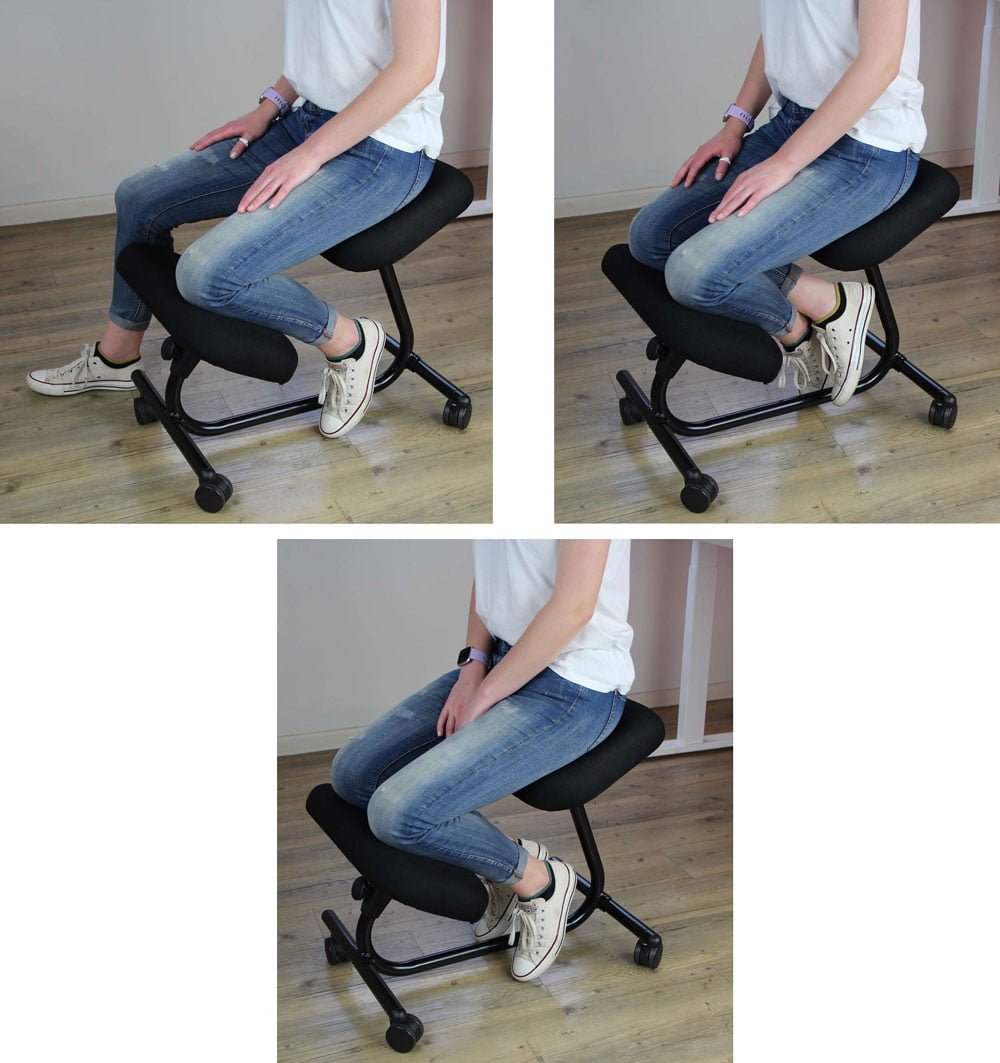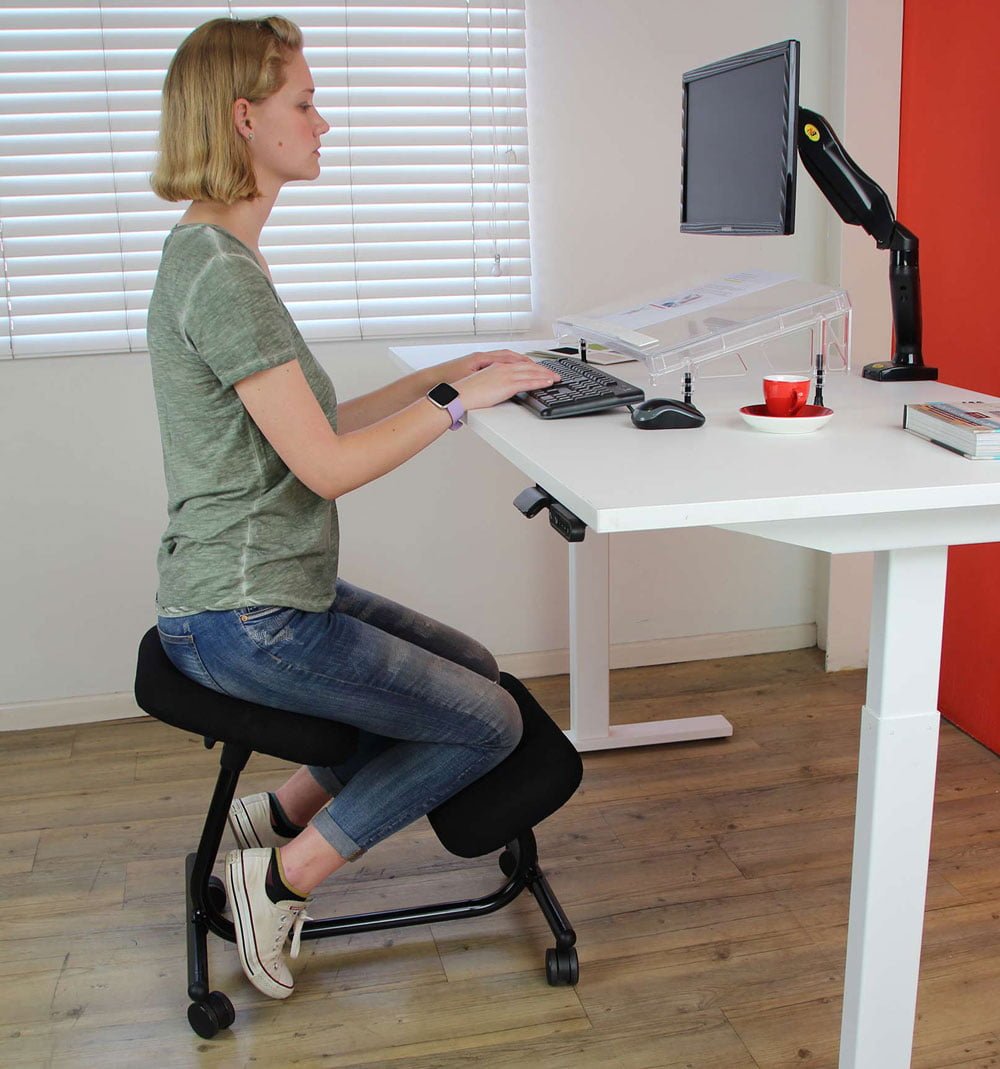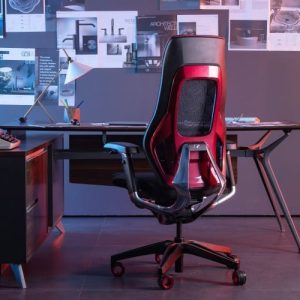
What are the Pros & Cons of a Modern Office Chair?
Modern office chairs with a mesh backrest have become extremely popular, but are they comfortable, and what are the pros and cons?
You may have seen kneeling chairs for sale online, in shops, or even in offices around South Africa. Perhaps your friends have bought one, and you’ve heard that these chairs alleviate lower back pain. Now, you’re considering buying one and wondering, “What are the pros and cons of a kneeling chair, will it improve my posture, and above all, is it suitable for me?”
The answer is a straightforward “yes”, provided you understand the ergonomic principles of a kneeling chair and know how to use it correctly.
When you sit in a traditional manner with your thighs at a 90-degree angle to your back, your body undergoes significant changes.
As you start to sit, your thigh bones (femurs) rotate in their pelvic sockets by about 60°. However, your body's physical limitations prevent the femurs from rotating the full 90° required, so the remaining 30° must come from "somewhere".
When you sit down completely, the ligaments attaching your femurs to your pelvis pull on the back of the pelvis, rotating it backwards by the remaining 30°. This rotation causes a flattening of the lumbar curve.


Sitting on a conventional chair changes the natural inward curve of your lower back to an outward curve. This shift occurs mostly in the first three or four lumbar vertebrae. As this happens, the front edges of the vertebrae squeeze closer together, while the back edges spread further apart. This increases the pressure on the front portions of the intervertebral discs, leading to discomfort and potential long-term issues.
Understanding these changes highlights the importance of choosing an ergonomic chair that supports your spine's natural curvature, reducing pressure on your intervertebral discs and promoting better posture and comfort. Breaking Back – What actually happens when you sit?
In South Africa, the name “kneeling chair” might sound like your knees take most of your weight, but that’s not true. Your buttocks still support about 80% of your weight. The knee pad takes the remaining 20% and stops you from sliding off the inclined seat.
A kneeling chair helps you maintain an ‘open’ pelvis while sitting. An ‘open’ pelvis is when the angle between your thighs and spine is greater than 900, typically between 100 and 1100.
An ‘open’ pelvis reduces the strain on your lower back that usually happens with conventional chairs. This change significantly improves your posture and reduces back pain, making kneeling chairs a great ergonomic choice.

By opening the pelvis to create a 1100 back-thigh angle, the disc pressure in the lumbar region of the spine is reduced by up to 65% compared to the traditional 900 sitting position. Sitting on a kneeling chair with a 1100 back-thigh angle, is like riding a horse.
As with all things, there are numerous pros and cons of kneeling chairs.
Kneeling chairs create a 110-degree angle between your back and thighs, compared to the 90-degree angle in traditional chairs. This more natural spinal curve reduces pressure on your lumbar discs.
With an improved posture, kneeling chairs help reduce lower back pain.
Opening the pelvis reduces compression on internal organs and abdominal muscles, making breathing easier and digestion better.
Without a backrest, your core and back muscles are more engaged, strengthening your core.
Engaged core muscles improve blood circulation, delivering more nutrients and oxygen to your brain and body, making you feel more energised.
Better blood flow to the brain helps improve concentration.
Proper spinal alignment prevents fatigue and discomfort, boosting productivity.
Kneeling chairs mainly improve lower back posture. Consult a professional if you have upper back issues or are unsure if a kneeling chair is right for you.
These chairs support your knees and/or shins on a pad, which can limit leg movement. It may take a few days to get used to sitting in this position.
Kneeling chairs position you higher than conventional chairs. You may need to raise your working surface to avoid leaning forward, which can negate the posture benefits.
The pressure on your shins from the knee pad can be uncomfortable at first and may take a few days to get used to.
Kneeling chairs may restrict leg circulation. If you have circulation problems, seek professional advice before using one. Start with short periods and alternate with regular chairs.
Some kneeling chairs have a scissor-type design, making them hard to sit on and get up from. Choose a chair that is easy to use.
Somer people may initially find it difficult or uncomfortable, to sit on a kneeling chair. This is a common experience and understanding why it happens can help you adapt more easily.
Remember, sitting on an office chair and a kneeling chair are two entirely different experiences. Your body needs time to adjust to an open posture seated position. Just like when you change cars or buy new shoes, it takes time for your body to get used to the new setup.
Your muscles and bones, accustomed to a traditional seating position, will need to adapt to the kneeling chair. Your body needs to rebuild the core muscles in your lower back, which might have weakened from sitting in a conventional chair. Give yourself time to adjust and you’ll soon enjoy the benefits of improved posture and reduced back strain.
Your body needs to adapt to sitting on a kneeling chair.
When Peter Opsvik designed the original Balans ergonomic kneeling chair in 1979, he focused on promoting movement and variation. Opsvik understood that staying in the same position for too long is harmful to your body.
With a posture chair, there is no one particular correct position that you are required to sit. Rather you should change your position on the kneeler frequently as this will result in improved blood circulation and also relieve some of the pressure points on the knees and shins, thereby reducing any possible discomfort.
With a kneeling chair, there is no one correct sitting posture.
As Opsvik stressed, it is important to vary your seated position on the kneeling chair frequently. Do not continuously sit in the same static position as fatigue and muscular pain will quickly result.
When you initially sit down, first sit on the seat of the kneeling chair before moving into the kneeling position.
The bulk of your weight (roughly 80%), should be supported by your buttocks, and the remainder (roughly 20%), is supported by your shins.

The height of your chair with respect to your working surface is the foundation of good posture.


Your work surface is at the correct height when the angle of the elbows is approximately 90 degrees.
Your forearms should be in line with the top of your working surface and your palms should be resting flat on the table.
What is the correct ergonomic height for my desk, computer monitor and office chair?

To achieve the correct height between you and your working surface, start by adjusting the seat pad of your kneeling chair. Once the seat height is correct, adjust the kneepad to a comfortable position.
It’s crucial to choose a kneeling chair with independent seat and kneepad adjustment, as many models sold in South Africa don’t have this feature.
Sometimes, you might find that the kneeling chair’s height can’t be adjusted to match your work surface, which is often too low. In these cases, you will need to consider raising the height of your work surface or desk.
There are some easy ways of doing this. For example, by using books to increase the height of the work surface – refer the perfect office setup. A more elegant solution would be a height adjustable desk. These can easily be set to the correct height irrespective of the type of chair you are sitting on. Height adjustable desks have many pros and few cons and can be used in conjunction with a kneeling or conventional office chair. Some companies, like Uber South Africa, truly understand the ergonomic advantages of such desks and have furnished their entire offices with adjustable desking. Best practices for ergonomics in the workplace.
There are many types of kneeling chairs available in South Africa, each with its own pros and cons. It’s essential to do your research and try out different models. Make sure you sit correctly on the chair and adjust the seat height to fit your work surface.
It’s wise to keep your existing office chair so you can alternate between the two as you get used to your new kneeling chair. Many users find that using both chairs is beneficial, and this is a recommended approach.

Modern office chairs with a mesh backrest have become extremely popular, but are they comfortable, and what are the pros and cons?

With exceptional functionality, style & ergonomic design, the Leila is the best value office chair in South Africa.

With the emergence of remote and hybrid work, people are spending more time working and relaxing at home. 10 ideas for creating a good all-in-one home office gaming setup.


